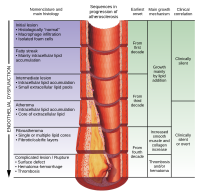
Photo from wikipedia
OBJECTIVE Recent data indicate social determinants of health (SDOH) have a great impact on prevention and treatment outcomes across a broad variety of disease states, especially cardiovascular diseases. The Area… Click to show full abstract
OBJECTIVE Recent data indicate social determinants of health (SDOH) have a great impact on prevention and treatment outcomes across a broad variety of disease states, especially cardiovascular diseases. The Area Deprivation Index (ADI) is a validated measure of neighborhood level disadvantage capturing key social determinate factors. Abdominal aortic aneurysm rupture (rAAA) is highly morbid, but also preventable through evidence-based screening. However, the association between rAAA and SDOH is poorly characterized. Our objective is to study the association of SDOH with rAAA and screening age. METHODS This was a retrospective study of patients who underwent operative repair of a rAAA at a multi-hospital healthcare system (2003-2019). Deprivation was measured in ADI (scale 1-100), grouped into quintiles for simplicity, with higher quintiles indicating greater deprivation. Patients with the highest quintile ADI (89-100) were categorized as the most deprived. We investigated the association between neighborhood deprivation with the odds of i) undergoing repair for rAAA before screening age 65, and ii) undergoing endovascular aortic repair (EVAR) using logistic regression, sequentially modeling non-modifiable then both non-modifiable and modifiable confounding variables. RESULTS 632 patients met inclusion criteria (age 74.2 ± 9.4 years; 174 [27.6%] women; 564 [89.2%] White, ADI 66.8 ± 22.3). Those from the most deprived neighborhoods (n=118) were younger (71.7 ± 10 vs 74.8 ± 9.2 years; p=0.002), more likely to be female (36% vs 26%; p=0.031), more likely to be Black (5.9% vs 0.4%; p=0.007), and fewer underwent EVAR (28% vs 39.5%; p=0.020) compared with those from other neighborhoods. On sequential modeling, residing in the most deprived neighborhoods was associated with undergoing rAAA repair before age 65 after adjusting for non-modifiable factors (OR 2.02; 95% CI 1.39-2.95; p<0.001), and non-modifiable as well as modifiable factors (OR 2.22; 95% CI 1.56-3.16; p<0.001). Those in the most deprived neighborhoods had a lower odds of undergoing EVAR compared to open repair after adjusting for non-modifiable factors (OR 0.64; 95% CI 0.41-0.98; p=0.042), and non-modifiable as well as modifiable factors (OR 0.61; 95% CI 0.37-0.99; p=0.047). CONCLUSIONS Among patients who underwent rAAA repair, residing in the most deprived neighborhoods was associated with greater adjusted odds of presenting under age 65 and receiving an open repair. These neighborhoods represent tangible geographic targets that may benefit from a younger screening age, enhanced education, and access to care. These findings stress the importance of developing strategies for early prevention and diagnosis of cardiovascular diseases among patients with disadvantageous SDOH.
Journal Title: Journal of vascular surgery
Year Published: 2022
Link to full text (if available)
Share on Social Media: Sign Up to like & get
recommendations!